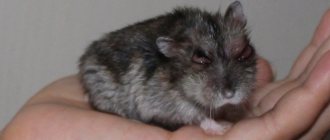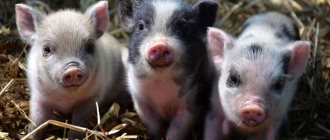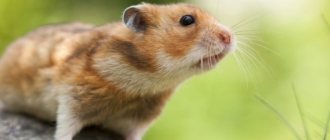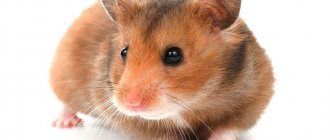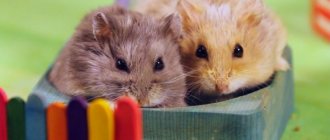Anatomical structure of hamsters
Hamsters of different species have similar body structures. Dimensions can vary from 5 to 34 cm. Weight ranges from 10 g to 1.5 kg. Their special anatomy helps them survive in their natural environment. Each breed has its own distinctive characteristics. How many chromosomes a hamster has depends on its species. Some have 22, while others have 28.
Rodent head
The rodent's head is disproportionately large in relation to the body. It is moderately elongated. The ears are mobile and have a round shape. The eyes are set high, which provides a wide viewing angle. There are 16 teeth in the oral cavity, 12 of them are molars, and 4 are incisors. They grow throughout life, grinding off the rough food that the rodent consumes. There is a diastema between the chewing teeth and the incisors.
The rodent's head is larger than its body.
The main anatomical feature of hamsters is cheek pouches. The entrances to them are located on both sides, and their bottom is located deep in the neck near the shoulder joints. They will mix up to 18 g of feed. To extract grains from them, the animal uses its front paws.
Some species also use cheek pouches for protection. The beast inflates them, trying to look larger and more aggressive.
animal body
The rodent's body is compact. The legs are short. The joints of the lower and upper extremities are quite mobile. The body is covered with thick hair. The color depends on the breed. Many species have 4 toes on the front legs, and 5 on the hind legs. Like other mammals, the spine consists of the lumbar, thoracic and cervical regions. The skeletal elements are quite fragile. Males of most breeds have scent glands on their bellies. Females do not have these organs. Some have a short tail, and its length does not exceed 5 mm, while in others it reaches 10 cm.
Why determine the sex of a hamster
Why do you even need to figure out how to determine the sex of a hamster? If this issue is not important for you, then you don’t have to go into it. It's another matter if you want to get a female or a male.
Unscrupulous sellers can often give false information about the sex in order to quickly sell a “staying” rodent. They resort to tricks, refer to their experience and assure that this is the furry that the buyer really needs. To avoid becoming a victim of scammers, it will be useful to be able to understand the differences between the sexes yourself.
It is also important for those who breed them to distinguish males from females. By mistake, same-sex animals can be placed together for mating. Don't want to watch such an incident? Then hurry to find out how to never encounter him.
Rodent distribution
The largest populations of hamsters live in steppe and forest-steppe zones. In addition, some species live in wet areas along rivers and in mountains at altitudes of up to 3600 m above sea level. Rodents often prefer rice fields, vegetable gardens, orchards and other cultivated areas. Their range covers a large area. Large populations are present in Eastern and Central Europe. Hamsters are also found in Siberia and Asia Minor. Especially many animals live in Iran, Syria, Mongolia, Korea and China. To provide the necessary conditions for the hamster, you need to know where the species was brought from.
Hamsters live in steppe zones.
How to properly bury a hamster
Place the deceased pet in a cardboard box. Then choose a suitable burial place. It is better to do this in the forest or in a field, away from residential buildings. Dig a hole 30-40 cm deep, then place the container inside and cover it with earth.
If you cannot bury the animal yourself, contact a veterinary clinic. There, for a small fee, the animal is cremated. More often, the animal is burned along with other dead pets, but a number of clinics offer individual cremation, in which only one body is sent to the oven.
Known varieties of hamsters with a description of appearance
In addition to simple hamsters, which are often kept at home, there are quite rare species in nature. They differ not only in their habitat and external characteristics, but also in their habits.
Common hamster
These are the largest domestic hamsters. Their body length reaches 20–25 cm. The color is often tricolor. The abdomen is black, the back and upper part of the head are red, and the fur on the sides, face and legs is light beige. These animals are quite freedom-loving and aggressive. More often they choose only one owner, and do not allow the others to approach them.
Many owners are surprised by how good these hamsters have a memory. They quickly remember the location of accessories in the cage. In addition, after a short time, pets begin to recognize the people with whom they come into contact. At home, solitary confinement is recommended, because in nature, this species zealously defends its territory, therefore, when a pair of adult individuals is placed in a limited area of a cage, there is a high probability of fights between them.
The common hamster is a large domestic animal.
Barabinsky hamster
The Barabinsky hamster looks like a mouse with a short tail. This species is widespread in Transbaikalia, Western Siberia and Mongolia. He prefers steppe zones. The body length of the animal is 12–13 cm. The tail does not exceed 3 cm. The fur on the back, head and sides is gray-red, and on the abdomen it is light. The peculiarity of the species is the presence of two-color ears. There is a white border along the edges. The species is prolific. Females can bear offspring up to 2–5 times a year. Rodents live in small groups of up to 5 individuals.
At home you can keep them in pairs. They are non-aggressive and quickly get used to their owners.
Djungarian hamster
The Djungarian hamster is a dwarf species. The body length does not exceed 10 cm. In most cases, the animals are smaller. Their weight is 30–60 g. Under natural conditions, they live in the steppes and semi-deserts of China, Kazakhstan and western Siberia. Color – gray-brown. There is a black stripe on the back that runs along the spine. In addition, there is a dark diamond-shaped spot on the crown. Through selection, subspecies with gray, cream-red, brown-gray and white coat colors were bred.
These creatures easily make contact with people. They quickly get used to their owners and love to be held. Rodents are hostile towards their relatives. It is acceptable to keep small hamsters together for up to 1 month. It is necessary to change the litter regularly to avoid the appearance of an unpleasant odor.
The Djungarian hamster is tiny in size.
Syrian hamster
The species naturally lives in Syria and Turkey. When determining at what temperature hamsters live, you need to take this fact into account. Rodents are thermophilic; if exposed to the cold for a long time, they can get sick and die.
The back, head and sides are covered with reddish-brown hair, and the legs and belly are beige. Body length – 13–18 cm.
They are able to remember information for a long time and easily recognize their owners even after a long break in communication. Animals are active and inquisitive. At the slightest opportunity, they leave the cage to explore the surrounding space. Syrian hamsters love to run on wheels and walk through mazes.
Campbell's hamster
Campbell's in pet stores may also be called the Russian dwarf hamster, but this name is not entirely correct. Body length does not exceed 8–10 cm. The coat is thick. It is gray-brown on the back and beige on the belly. The paws are furry. On the back there is a faint dark stripe running along the spine. The length is 7.5–10 cm. The weight does not exceed 60 g. The tail reaches 1.5 cm.
Campbell's hamster is a Russian dwarf hamster.
In nature, rodents live in small family groups, but when kept at home, they should be housed one at a time to avoid fights between animals. It is difficult to tame these creatures.
They bite, so it is recommended to handle them only with gloves. Males have developed scent glands, so it is necessary to frequently change the bedding in the cage.
Roborovsky's hamster
Roborovsky's hamster is a dwarf species. It is found naturally in Northern China and Mongolia. The length does not exceed 4–5 cm. The body is covered with thick sandy-yellow hair. The brow ridges, abdomen, muzzle and paws are lighter. The rodent has rather fragile bones, so it is not recommended to handle it. Several same-sex adults can be kept in one cage. They will get along well with each other. These pets are most active in the evening and at night. They are fertile. 3–4 generations may appear in a year.
Transcaucasian hamster
The species' range covers the territory of Lebanon, Israel, Turkey and eastern Ciscaucasia. In nature, they inhabit the slopes and meadows of mountains. Animals often act as pests, attacking agricultural crops, orchards and vegetable gardens. The length reaches 15–18 cm. The weight of an adult is 250–300 g. The length of the tail is 2–3 cm. The ears are small. The rodent's body is covered with thick brown-gray fur. There are long black spots on the chest and near the ears. The chin and paws are beige-white.
The Transcaucasian hamster inhabits the slopes and meadows of the mountains.
These animals are quite aggressive. They are difficult to tame. It is recommended that they be installed by specialists. It is permissible to keep only one hamster in a cage at home. These creatures do not tolerate each other's company well. When several individuals live together, fights are possible, in which the weaker rodent will suffer.
Cis-Caucasian hamster
The Cis-Caucasian hamster, also called Radde, is a large animal. The length of its body reaches 28 cm. The tail is short. The fur on the back is brown. The belly is black. There are light spots on the cheeks and areas behind the ears. Paws are white. The species is distributed in the North Caucasus, Russia, Georgia, Ciscaucasia and Stavropol Territory.
Radde are rarely kept as pets. It is nocturnal. Throughout the day, the hamster hides in a hole. The animal is non-contact, so difficulties often arise with its taming. You need to be extra careful when purchasing. You cannot purchase rodents that have been caught in the wild, even if they were caught at an early age. Such individuals can act as carriers of many dangerous diseases.
Newton's hamster
Hamsters of this species began to be kept at home as pets relatively recently. In nature, the range of these creatures is limited to a small area on the right bank of the Danube, covering the northern regions of Romania and Bulgaria. These hamsters naturally settle in dry areas of barren forest and steppe zones.
Newton's hamster is a species of domestic rodent.
The length of the animal is 14–17 cm. Females are larger. The length of the tail is 1.8–2.6 cm. The weight of the rodent reaches 80–150 g. The body of the hamster is covered with thick gray-brown hair. A dark stripe stretches from the forehead to the middle of the back. The chest and throat are black and brown. The belly is yellow-gray.
In nature, the animal leads a solitary lifestyle. It is most active at night. The species is resistant to many diseases and is omnivorous.
The rodent is easily tamed. However, if there is no contact for a long time, the animal may forget its owners.
Short-tailed hamster
The short-tailed hamster is easily confused with a mouse. The length of the animal is 8–10 cm. Its weight reaches 22–48 cm. The body is covered with thick gray-brown hair. There are no spots. Tail length is 2–3 mm. In its natural environment, this species lives in the mountains of northern China, at an altitude of up to 4 thousand meters above sea level. They prefer birch and coniferous forests, as well as meadows.
Hamsters quickly get used to their owners, but at the same time they can behave aggressively towards their relatives. It is permissible to keep same-sex young individuals. The skeleton of a rodent is quite fragile, so you should handle the animal as carefully as possible.
Gray hamster
Gray hamsters are most often kept at home. Their length is 10–13 cm. The tail reaches 3.5 cm. The fur on the back and head is gray. The tail and belly are white. The eyes are big. The ears are small and almost invisible from the thick fur. Under natural conditions, adult individuals often live in small groups, but at home it is better to keep only one rodent, because staying in a limited area of the cage can lead to fights. The animal is sociable and quickly gets used to its owners.
The gray hamster is a small animal.
Hamster Sokolov
This is a relatively recently discovered and poorly studied subspecies of gray hamsters. The length of the animal does not exceed 11.5 cm. The fur on the back and sides is gray-red. The abdomen is light. Tail length – 2 mm. How long hamsters of this species grow is not known. They live in a limited area of China and Mongolia.
There is little information about the characteristics and lifestyle of rodents, so they are not suitable for home keeping.
Mongolian hamster
The Mongolian hamster has an unusual appearance. Body length – 14 cm. The tail is short. Its length does not exceed 2 cm. The eyes are large and the ears are small. The back and sides are covered with light gray thick hair. The abdomen, paws and tail are white. In nature, the species is distributed in Mongolia, China and Russia. It is listed in the Red Book. The animal is only suitable for single keeping. It is not aggressive towards people and only bites if it senses danger.
The Mongolian hamster has an unusual appearance.
Eversman's hamster
Eversmann's hamster is a medium-sized rodent, the length of which is 16 cm. The tail is short and has a flattened shape. It is covered with thick fur. The ears are small. The eyes are large. The fur on the back is dark brown. The belly is grey-beige. There are brown spots on the chest and throat. The paws and underside of the tail are white.
The species is distributed in the Trans-Volga region, as well as in the south of the Trans-Urals and Kazakhstan. Eversman's hamster is listed in the Red Book. The animals are quite calm. They rarely behave aggressively.
In this case, solitary content is recommended. The species is resistant to many diseases.
Canese hamster
The length of the Kansky hamster is 10–17 cm. Females are larger than males. Weight reaches 120 g. The body is covered with thick hair. The back is gray with white patches near the ears and on the cheeks. Tail length – 2 mm. The belly is white. This species is common in Central China and was considered arboreal for a long time. However, it was recently discovered that they can also make nests among stones. The animal is active only at night. It's difficult to tame him.
The Kansky hamster is covered with thick fur.
Rat hamster
This is a large species. The length of an adult is 14–25 cm. The tail reaches 10 cm. Externally, the hamster looks like a rat. Weight is 100–240 g. The back is covered with thick gray-brown fur. The tail is dark brown. Its tip is white. The paws and belly are beige. The species lives in the northeast of China, in the south of Primorye, and also in Korea. These hamsters are not kept at home, because... They are difficult to tame and often show aggression towards people.
How to distinguish boy hamsters from girls: determining the sex of baby hamsters
The newly born cubs are incredibly cute and funny to look at. However, they are very similar to each other. Their paws, tails and primary genital organs are barely noticeable - it is very difficult to determine gender from them. It is difficult not only to distinguish them from each other, but also to simply look at them in order to compare. In this case, there is an additional “tip” - the odorous gland.
Only boys have it. Located on the stomach in the navel area. This place is a small bald patch of yellow color. The male will soon begin to mark his territory with it. Accordingly, females do not have such a gland.
Sex determination in female hamsters
A sure sign that you are buying a female furbaby is the presence of nipples. If you carefully run your finger over the tummy, they can clearly be felt in two rows. Boys have no nipples at all. They are no more and no less, they simply do not exist. If the seller convinces you otherwise, feel free to turn around and leave: in front of you is a typical liar.
If Djungarians or Syrians are of the same litter, then their age is the same. In this case, it is worth paying attention to the size of the individuals. The smaller ones are male, the larger ones are female, but this is not an accurate way to determine gender.
Master, by the time you look at something, I’ll already fall asleep...
How to determine the sex of a boy hamster
The most reliable way to determine the sex of male animals is the presence of testes. They are an almond-shaped bulge, which is located in the perineum. It can be considered at about 40 days of age. But in some cases, the testes are invisible, and potential owners or breeders mistakenly believe that they are looking at little “ladies.” Why are the testes not always visible? There may be several reasons:
- early age (gender characteristics in children are barely distinguishable);
- underdeveloped genitals;
- lack of descent of the testicles into the scrotum (rare cases).
Only an experienced professional with a veterinary education can understand such issues. Since, if the testicles do not descend for a long time, but remain in the abdominal cavity, then it makes sense to talk about a disease such as cryptorchidism.
No, you can’t lure me out. Stop looking between the paws, it’s a shame...
Character and habits of the animal
Most species of hamsters are nocturnal animals. During the day they sleep. If a rodent is constantly disturbed in the morning, this can negatively affect its health and cause aggressive behavior. Hamsters are loners. Outside the breeding season, they do not tolerate proximity to their relatives.
This is due to the fact that in natural conditions they have to make a lot of effort to find food.
Animals gnaw everything they can get their teeth on. They can try cage bars, toys, a playhouse and other accessories. Even when kept at home, when there is no shortage of food, they try to stock up. In nature, they cover long distances, so at night the animals run in a wheel to satisfy their need for movement.
Cognitive Features
A hamster's cognitive abilities depend on its breed. Experts have found that most animals have a fairly good memory.
Most hamsters have a good memory.
Some rodents are able to remember events and even recognize people's faces. Because of this, the pet can go into the arms of only one family member, hiding from others. With regular training, he is able to learn how to perform some simple tricks.
What are they afraid of?
Hamsters are hunted by many predators in their natural environment, so the rodents are quite shy. Fear and the stress it causes can shorten your pet's life. Hamsters are often afraid of people. This is due to the fact that the animals are quite small and larger living creatures can pose a danger to them. To rid your pet of fear, you need to treat him with the utmost care. Hamsters are afraid of:
- sharp sounds;
- drafts;
- water.
Most animals do not have an innate fear of heights. The rodent may fall from a table, the top tier of a cage, or a shoulder. Only after this does he develop a fear of heights, because... it begins to be associated with pain.
Secondary signs for gender recognition
How else can you determine gender? The symptoms described above are considered the most common and basic. But besides them, there are also secondary “signals” that are worth paying attention to.
- Back shape. If you rub your hamster's back, you will notice certain differences. In males it is pointed and slightly raised at the tail. Females have smooth and wider backs.
- Testes under pressure. If you cannot visually see the testes, you can try to gently press on the area around them. Usually they begin to appear outward. A similar thing happens in boys. Girls do not have testes, and, of course, there is nothing to manifest themselves.
I admit it myself, just don’t look for anything else!
Rodent health
Most species are in good health. Older individuals whose body resources are almost exhausted are more likely to get sick.
Lifespan
In nature, rodents rarely live beyond 1 year. This is due to the activity of natural enemies. At home, the life expectancy of most species reaches 3 years.
In nature, rodents reach 1 year of age.
Frequent illnesses
Most often, an animal's health deteriorates due to injury. Damage often occurs due to falls, strong squeezing, and fights with relatives. In addition, metabolic disorders are often diagnosed in older rodents. Your hamster may develop diabetes. Some illnesses are caused by fear and stress. Such pathologies include heart attacks and strokes. These disturbances often lead to the death of old individuals.
It is relatively rare for hamsters to have problems with stool caused by poor diet or intestinal infections. When staying in a draft and getting the fur wet, there is a high probability of developing a runny nose and pneumonia. With a strong decrease in immunity in an adult, the eyes may turn sour. Without treatment, there is a high likelihood of an abscess forming. Some species are predisposed to dermatitis. With age, the risk of developing malignancy increases.
Is it possible to save a dying hamster?
In some cases, it is possible to resuscitate a dying animal.
In what cases is it possible
Young animals are more often saved. If you notice signs of a cold, loss of appetite, change in coat quality, or lethargy, contact your veterinarian immediately. The doctor will tell you how to help your hamster, select the appropriate treatment if necessary, and give advice on caring for the rodent.
When you can't help
If the hamster is already old, paralyzed or seriously injured, it will not be possible to “resurrect” it. It is also impossible to cure oncological pathologies and severe infectious diseases. In such situations, it is recommended to euthanize the animal, since hamsters with such diseases die for a long time, painfully.
Keeping and caring for a rodent
Hamsters are unpretentious and do not require much space. At the same time, the arrangement of a pet’s living space must be taken with full responsibility. The cage must contain all the elements to satisfy the animal's needs.
Cage and accessories
The size of the bottom of the cage should be at least 50x30 cm. Two-tier structures are more suitable for keeping hamsters. The height of each floor must be more than 30 cm. The recommended distance between the rods is 1 cm. The cage must be equipped with a continuous removable tray. This will make the cleaning process easier.
It is better to buy a mounted drinking bowl. It clings to the bars of the cage, so the hamster cannot turn it over and wet itself and the bedding. A floor feeder is required. The recommended depth of the container is 2–2.5 cm. It must be made of heavy metal. In this case, the animal will not turn over the feeder, and the grains will not be lost in the bedding.
The hamster's cage should be spacious.
It is imperative to place a house inside the cage. It is better if it is woven from grass. In addition, it is recommended to install several driftwood. Be sure to have a container of sand with which the hamster can clean its fur. You need to buy a carrier. It will be convenient to place your pet in it while cleaning.
A hamster's teeth grow throughout its life, so to wear them down it is important that the rodent eats rough food. It is advisable to place a mineral stone or chalk in the cage. The hamster should have branches of fruit trees available. It is advisable to arrange a sports area so that the pet can expend energy. It is recommended to install a wheel in which the animal can run. In addition, a labyrinth and a staircase system should be secured in the cage.
Feeding ration
Hamsters are conditionally omnivorous, because... Their diet includes not only food of plant origin, but also insects. Errors in nutrition can cause serious illness in them. A balanced diet for a rodent includes up to 20% proteins, 6% fats, 10% fiber and up to 65% carbohydrates. The basis of the hamsters’ diet is grain mixtures from:
- oats;
- wheat;
- millet;
- buckwheat;
- field grass seeds.
You can give apples, persimmons, turnips, zucchini, raspberries and carrots in doses. Grain mixtures should be given to the hamster once a day. It is advisable that the animal always has dry or green grass available. The animal should be fed vegetables once every 2–3 days. The recommended serving size is 10–15 g. Berries or sweet fruits are given to the rodent once a week.
Hamsters eat a variety of foods.
It is advisable to periodically feed your pet with caterpillars and food crickets.
Selection of filler
Sawdust or wood pellets are often used as filler. In addition, the use of chopped hay is acceptable.
Hygiene features
Hamsters do not require specific care. Short-haired individuals are able to independently monitor the cleanliness of their fur and remove dead hairs. Long-haired animals need to be combed. It is advisable to remove the remains of succulent food after each meal of the hamster. It is recommended to completely change the litter once a week. When cleaning, feeders, drinking bowls, ladders, wheels, etc. should be disinfected.
Taming an animal
You can only have contact with an awake pet. You should pick him up as carefully as possible, supporting him under his front paws. It is important that the rodent does not experience any discomfort. You should speak in a quiet voice. In this case, the pet will quickly get used to the person and will run up to the bars of the cage when it sees the owner.
You can only tame an awake hamster.
Determination of gender
To find out the gender, you should examine the pet's lower abdomen. In females, the distance from the anus to the genitals is about 1 cm, and in males it is approximately 0.2 cm. Females have less thick fur on their bellies.
How to properly prepare your hamster for examination
Before you begin an examination to determine gender, you need to know how to conduct it correctly. To do this, we perform the following algorithm of actions:
- We carefully take the baby in our hand so that his body is in the ring of the index finger and thumb;
- With your second hand, if necessary, carefully support the baby’s back;
- make sure that the bottom of the hamster hangs from the hand;
- We carry out an inspection as quickly as possible, take a photo and lower the animal into place.
Under no circumstances should you turn an animal over on its back or pick it up by the scruff of the neck. By these actions you can harm him and cause pain. To avoid falling, you can check the floor over the bed or a soft terry towel. Do this when the rodent is in a calm position. The optimal time is immediately after sleep, when the baby is relaxed. This will prevent aggression and reduce the risk of injury from sharp teeth.
Gender must be determined quickly. You can't hesitate. If you don’t have time to see everything, then quickly click the camera on your phone or camera. Excessive slowness can lead to serious stress for the fluffy. You don't want to scare him, do you?
Hold me gently... otherwise I'll chew on you!
Interesting facts about pet hamsters
The following interesting facts are associated with domestic hamsters:
- The animal can stuff the amount of grain into its cheek pouches, the mass of which is up to 15% of its body weight.
- The young are born blind and naked, but already with teeth.
- Forest species have a craving for shiny objects, trying to immediately carry them into the hole.
- Over the course of a year, an adult can make reserves that weigh up to 90 kg.
- Female dwarf hamsters can delay childbirth in order to continue the period of feeding their young with milk.
- Keeping such pets in Vietnam is prohibited, because... Rodents are carriers of many diseases.
Chinese scientists have found that some hamsters travel up to 1 km per night to get to a place where there is food. In addition, research has revealed that during a hungry period, an animal is capable of falling into a state of torpor, in which all processes in the body slow down, allowing the animal to survive unfavorable times.
When can you determine the sex of a hamster?
How to learn to determine the sex of a pet hamster? This can be done based on certain criteria. These include:
- presence of testes;
- the distance between the genitals (urethra and anus);
- presence of nipples;
- presence of an odorous gland on the tummy.
Recognizing that your hamster is a girl or, on the contrary, a boy is much easier in adulthood. Then sexual characteristics are already clearly visible. But the problem is that it is necessary to determine whether a hamster belongs to one sex or another when the hamster is up to 3-4 weeks old. Just at this time, the babies should be placed in different cages: in one - male hamsters, in the other - girls. If you are late in this matter or mistakenly separate the offspring, then you can allow inbreeding.
Even if you do not plan to breed animals, but want to get yourself only one individual, then knowing exactly its gender is also important. You or your children will probably want to name their new little friend. It would be extremely ridiculous if the matured hamster turns out to be not the girl Ponochka at all, but Vasya in the prime of his life.
Floor? Breed?? Name??? Answer the question!!!
Reproduction and development of babies
All hamsters are “precocious” pets, their puberty occurs in 1-2 months. This is almost not reflected externally in females, but in boys the testicles begin to protrude. Sometimes they are so big that you are simply amazed!
Despite early sexual development in hamsters, care must be taken that they do not begin sexual activity too early. This is especially harmful for females, for whom pregnancy can end in death during childbirth. The optimal age for pregnancy is 4-5 months.
Here are some interesting facts about the reproduction of pet hamsters:
- pregnancy lasts about 3 weeks;
- after giving birth, within a week the female is able to become pregnant again;
- one married couple can produce up to 10 offspring per year!
- The number of hamsters in one litter can be from 4 to 15.
Newborn hamsters look very touching and defenseless. They are tiny, bald, with closed eyes. During the first days, the hamsters do not leave the nest, but within a week from the moment of birth they crawl throughout the cage in search of tasty seeds. At 2 weeks their eyes open and fluff appears on their body. And when the animals turn one month old, they are already completely independent.
Babies can be tamed after they open their eyes. Hamsters adapt to human interaction faster than adult hamsters. They are also easier to train.
Children of hamsters are shown in the photo:
Natural enemies of hamsters
In their natural environment, the life of these miniature rodents is full of dangers, because they are literally surrounded on all sides by predators. Moreover, the threat comes from both the ground and the air, so furry animals always have to be on alert.
The hamster is always on alert, recording any suspicious rustles and sounds
They are hunted by large animals such as wolves, lynxes and wild dogs. Cunning foxes and weasels often ambush near a hamster's burrow, patiently waiting for the prey to leave its shelter. Stoats, badgers and ferrets are also not averse to feasting on these animals, and they rarely manage to escape from clever predators.
Among the dense vegetation and fallen leaves, insidious snakes lie in wait for hamsters. Rodents are also defenseless against feathered predators. As soon as the animal relaxes its vigilance, it immediately becomes a victim of a hawk, owl or kite, which quickly attacks the unwary prey.
At the sight of an enemy, the hamster tries to escape, or freezes in one position, hoping that he will not be noticed. But, if all escape routes are blocked, the small rodent takes a threatening stance and rushes at the enemy. Although, given the size of the hamster, it is not difficult to predict the outcome of the battle between the brave baby and the hungry predator.
Lifestyle of a hamster in the wild
Looking at a miniature domestic hamster, it is difficult to believe that such a fragile animal can survive in captivity. But wild hamsters are strikingly different from cute decorative pets. In their natural environment, these are quite aggressive creatures that are hostile not only to other animals, but also to their fellow tribesmen.
In the wild, hamsters are vicious and aggressive
The European forest hamster, which is popularly called "karbysh", prefers not to waste time digging a hole, but takes away ready-made homes from other rodents, such as gophers or jerboas.
Lifestyle of hamsters
Fluffy rodents are solitary by nature, and do not want to share their home or the food supplies collected with hard work with anyone. A hamster's domain can extend over 8-10 hectares, and he will bravely defend his burrow and the surrounding area from the encroachments of any uninvited guests. Interestingly, male hamsters do not tolerate the presence of other males in their area, but they allow females to establish burrows there, with whom they mate during the mating season.
Battle of two males for territory
Hamster hole
Recommended by topic
Cow Horse Rabbit
The hamster's home deserves special attention. Actually, calling an animal’s home a hole would be a huge understatement. After all, these are real underground mansions, with an intricacy of passages, living rooms and a food compartment, going 2.5-5 meters deep into the earth. Clean rodents even set up a separate section as a toilet, and in the opposite direction from the utility pantry. And the females also have an additional room for giving birth and raising their young.
Sometimes hamsters build themselves several barns, each of which stores supplies for the winter. Also, furry animals dig small burrows on their territory, which serve as temporary shelter from predators.
Procurement of food supplies
With the onset of summer, the hamster begins to prepare for the long, cold winter by diligently filling the pantry with grain, seeds and vegetable tubers. The animal carries small provisions in its cheek pouches, and it has to carry root vegetables in its teeth, holding them with its front paw.
The rodent methodically puts all the food it finds by type, so vegetables, grains and seeds are stored in different corners. At one time, scientists who examined the barns of these animals were sure that the hamster even sorted types of cereals. But then zoologists, who studied this phenomenon in detail, found that the animal simply stocked up on wheat, barley and corn at different times, so it stacked each grain in a separate pile.
One hamster's pantry can store up to 90 kg of food supplies. In lean years, Chinese peasants even specifically search for their holes, ruining the grain reserves that the furry rodent has diligently collected for several months.
What do hamsters eat?
The diet of hamsters consists mainly of plant foods, although in the wild these animals are omnivores, and in order to survive, they do not hesitate to eat even carrion. True, this rarely happens, because in their natural habitats there is enough grain and grass, which is more than enough for feeding and for generous winter reserves.
Hamster eats grain
Among cereal crops, furry rodents prefer wheat, buckwheat, corn and barley. They also enjoy eating legumes, especially peas. In the spring, hamsters eat young shoots of trees and shrubs, and in the summer their menu is replenished with fresh greens: plantain, dandelion, clover. Moreover, the animals eat both herbs and their roots and seeds.
Hamsters will not refuse vegetables and fruits, and this is precisely why farmers do not like them so much. After all, enterprising animals, under the cover of darkness, devastate farmland, significantly reducing the harvest of potatoes, carrots and beets. As for fruits, there is no particular damage from the animals; they do not know how to climb trees, and only pick up fallen apples and pears. Also, rodents do not miss the opportunity to eat ripe raspberries, strawberries and blackberries.
Hamsters raided neighbor's farm
Furry animals diversify their menu with protein foods. Hamsters eat beetles, grasshoppers, caterpillars, and they do not disdain insect larvae. And for rodents that live in the lower reaches of rivers and near swamps, additional food is provided by mollusks, small crustaceans and fish left over from the meals of other animals.
It may seem incredible, but wild hamsters sometimes attack small field mice, and even chickens if there is no chicken near the chicks.
Ensuring activity
Keeping hamsters in tiny cages or a three-liter jar is cruel to the animal, which in nature runs several kilometers every day. It’s not for nothing that their home is equipped with a running wheel. Caring for hamsters may include providing them with leisure time. The owners set up entire playgrounds, labyrinths and tunnels for curious rodents.
Despite the need for movement and variety, you can only let your pet out for a walk around the apartment in a walking ball. Otherwise, the hamster at home is in mortal danger - it can get stuck, be crushed/pinched by a door, fall, fall into a pan, eat a poisonous plant, or chew through an electric wire. Catching a pet can be very difficult.
You cannot organize a walk on high surfaces (table, sofa). All hamsters come from the lowland steppes; they do not understand and are not afraid of heights. There is a high risk that the pet will fall.
Is it possible to walk a hamster outside?
With the best of intentions, some owners strive to let their pet spend time in nature. But the pet hamster will not receive pleasure from such a walk, but extreme stress. Not many people think about the fact that a pet can become seriously ill.
In nature, the animal is in wait for predators: dogs, cats, rats, crows. A nimble baby can easily run away and get lost forever. The outdoor environment is more aggressive and unstable: the hamster can become hypothermic, especially if the grass is wet, or overheat in the sun. The soil and grass are often infested with parasites and are a source of infection due to wild rodents.
Weight and size
In order to monitor your pet's health, you will need information about how much your hamster weighs. The size of these animals varies greatly depending on the breed. Let's look at several varieties in increasing order of size.
- Roborovsky's dwarf hamster. The maximum height of the animal is 4-5 cm including the tail.
- Long-tailed. The total length of the body is 10 cm, with 6 of them being the tail.
- Taylor. A miniature animal with a body length of 7-8 cm.
- Dzungarik. Another dwarf breed, the size of these fluffies is up to 10 cm including the tail.
- The Campbell's hamster is a larger breed, with individual sizes reaching 12 cm.
- Syrian (aka royal, golden). Quite a large animal with a peach color. Depending on the conditions of detention, the body length reaches from 12 to 18 cm.
- Radde. A large animal up to 28 cm tall. Strong, voracious. It is rarely found as a pet, but thrives quite well in nature.
Weight also differs between breeds. Thus, tiny Taylors weigh on average 8 g, healthy Djungarians - 30 g, and well-fed Syrians reach a weight of 150 g. At birth, dwarf rodents weigh only 1 g, and Syrians from 2 to 4 g (depending on the number of hamsters in the litter).
In the photo, the owners weigh their Campbell hamster:


